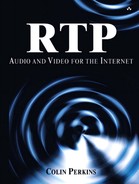Book Description
The Real-time Transport Protocol (RTP) provides a framework for delivery of audio and video across IP networks with unprecedented quality and reliability. In RTP: Audio and Video for the Internet, Colin Perkins, a leader of the RTP standardization process in the IETF, offers readers detailed technical guidance for designing, implementing, and managing any RTP-based system.
By bringing together crucial information that was previously scattered or difficult to find, Perkins has created an incredible resource that enables professionals to leverage RTP's benefits in a wide range of Voice-over IP (VoIP) and streaming media applications. He demonstrates how RTP supports audio/video transmission in IP networks, and shares strategies for maximizing performance, robustness, security, and privacy.
Comprehensive, exceptionally clear, and replete with examples, this book is the definitive RTP reference for every audio/video application designer, developer, researcher, and administrator.
Key coverage includes:
RTP's goals, design philosophy, and relationships with other protocols
The psychology of human perception in the design of media delivery systems
RTP data transfer and control protocols, including framing, loss detection, reception quality feedback, and membership control
Media playout, timing, and synchronization, including lip synchronization
Mitigating network problems: error concealment, error correction, and congestion control
Optimizing performance over low-speed links: header compression, multiplexing, and tunneling
Integrating leading media codecs and standards into RTP systems
Securing RTP sessions: encryption, authentication, and the new secure RTP profile for wireless networks
Extensive references and practical examples throughout
0672322498B05092003
Table of Contents
- Copyright
- Preface
- Acknowledgments
- I. Introduction to Networked Multimedia
- II. Media Transport Using RTP
- 3. The Real-Time Transport Protocol
- 4. RTP Data Transfer Protocol
- 5. RTP Control Protocol
- Components of RTCP
- Transport of RTCP Packets
- RTCP Packet Formats
- Security and Privacy
- Packet Validation
- Participant Database
- Timing Rules
- Summary
- 6. Media Capture, Playout, and Timing
- 7. Lip Synchronization
- III. Robustness
- IV. Advanced Topics
- 11. Header Compression
- 12. Multiplexing and Tunneling
- 13. Security Considerations
- References
